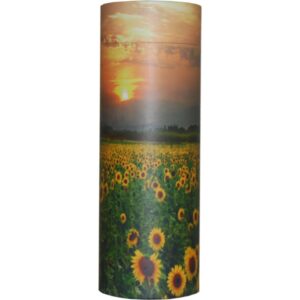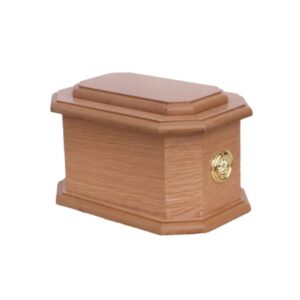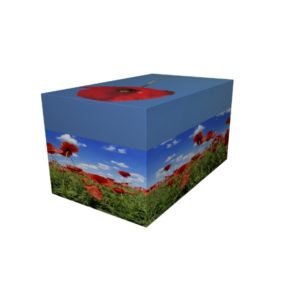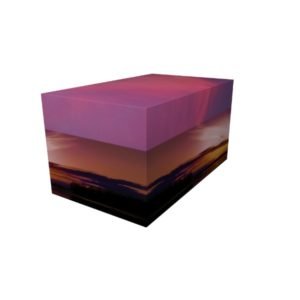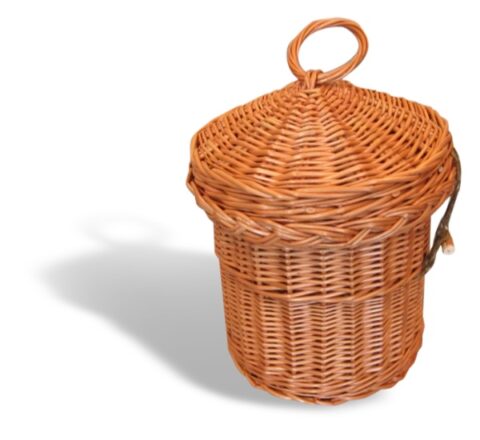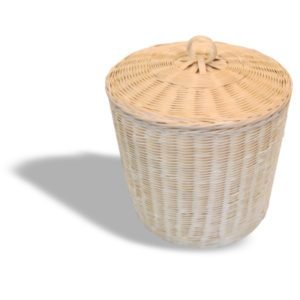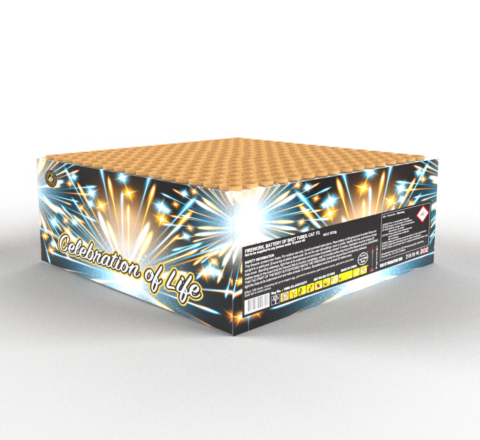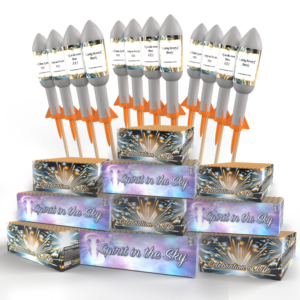History and Significance of Cremation Urns
A cremation urn is basically meant to hold the cremated remains or ashes received after cremating a dead body. During cremation, the human body is reduced to almost 3-7 pounds, depending on the size and weight of the individual. It is interesting to note that although we generally refer to cremains as ashes, the body does not actually turn into ash after incineration; it reduces into minute particles and pieces of bones that are further ground to get powdery consistency.
Anyway, coming back to urns, they are particularly used in cultures that recommend the process of cremation for disposing of the dead body. It is believed that this helps reduce the soul’s attachment to the body. Urns are also known as cremation urns, funeral urns, memorial urns, or cinerary urns. The tradition of using funeral urns for ashes was introduced by the Ancient Greeks. They were originally called lekythoi.
According to the experts, findings of the decorative pottery urns in western Russia among the Slavic or Indo-European people suggest that the practice spread across the Europe towards the end of Stone Age. Next, it advanced further into the Northern Mediterranean regions. Urns from Bronze Age have found in Hungary and northern Italy. During the Mycenaean period, Greeks used to cremate dead soldiers, store the resultant ashes in urns or in ashes casket and used these urns in ceremonies to honor the heroes. With the passage of time, people started displaying urns containing cremated remains in columbarium niches. The tradition started during the Roman Empire, and it is still prevailing. In fact, cremation became so prevalent that around the mid 5th Century AD, an official decree against the cremation of the bodies within the city had to be issued.
However, as certain sects like the early Christians and Jews were against cremation, the practice of earth burial (except in instances of famine, pestilence, and war) became prominent almost since 400 AD. The Eastern Orthodox Churches, Orthodox Jews, and Muslims discourage cremation even in the present times. Nevertheless, the cremation movement again started over a century ago when Professor Brunetti of Italy introduced the first cremation chamber model at the Vienna Exposition in 1873. So, the movement started simultaneously on both sides of the Atlantic.
Queen Victoria’s surgeon, Sir Henry Thompson, promoted the movement to avoid hazardous health conditions. In 1874, he founded the Cremation Society of England along with his colleagues. The first crematories were built in 1878 in Europe. In North America, the first crematory was built in 1876 in Pennsylvania. There were almost 52 crematories in the North by 1913. Thus, with the increasing rate of cremations, the demand for cremation or memorial urns is also increasing.
You can read up more about the history of cremation at the CANA (Cremation Association of North America) website.
People opt for elegant memorial urns not just for storing the cremated remains but also for showing their love and respect for the departed loved one.
These urns can be made of a variety of materials ranging from earthenware to metal and even glass. People usually use urns for ashes, wooden caskets for ashes, or wooden urns for ashes in the UK. With the emergence of pet crematories, decorative urns for pets, too, have become popular.
Choose From The Range Of Cremation Urns
-
Quick View£75.00
Exclusive to compare the coffin, These Printed cardboard cremation ash boxes are made from at least 70% post consumer waste sourced from local mills. Product and all materials are manufactured in the UK. Boxes are 100% biodegradable and are supplied fully assembled.The size is ( 28cm x 18cm x 15cm)
-
Quick View£46.00
Exclusive to compare the coffin. These Printed cardboard cremation ash scatter tubes are made from at least 70% post consumer waste sourced from local mills. Product and all materials are manufactured in the UK. Boxes are 100% biodegradable and are supplied fully assembled.
-
Quick View£150.00
Exclusive to Compare the CoffinThese spun Alimumium creamation urns are beautifully made with a laquer finish in a fair trade facility in VietnamA discount is available when ordering at the same time as any American Casket coffinsBuy a coffin or urn with complete confidence with the Comparethecoffin.com price promise?If you find the same coffin or casket of the same quality for less we will refund the difference.
-
Quick View£75.00
Exclusive to compare the coffin, These Printed cardboard cremation ash boxes are made from at least 70% post consumer waste sourced from local mills. Product and all materials are manufactured in the UK. Boxes are 100% biodegradable and are supplied fully assembled.The size is ( 28cm x 18cm x 15cm)
-
Quick View£46.00
Exclusive to compare the coffin. These Printed cardboard cremation ash scatter tubes are made from at least 70% post consumer waste sourced from local mills. Product and all materials are manufactured in the UK. Boxes are 100% biodegradable and are supplied fully assembled.
-
Quick View£46.00
Exclusive to compare the coffinThese Printed cardboard cremation ash scatter tubes are made from at least 70% post consumer waste sourced from local mills. Product and all materials are manufactured in the UK. Boxes are 100% biodegradable and are supplied fully assembled. Their capacity is 240 cubic inches and 15" (45cm) tall and 5" (13cm) diameter.
-
Quick View£46.00
Exclusive to compare the coffin. These Printed cardboard cremation ash scatter tubes are made from at least 70% post consumer waste sourced from local mills. Product and all materials are manufactured in the UK. Boxes are 100% biodegradable and are supplied fully assembled.
-
Quick View£46.00
Exclusive to compare the coffin. These Printed cardboard cremation ash scatter tubes are made from at least 70% post consumer waste sourced from local mills. Product and all materials are manufactured in the UK. Boxes are 100% biodegradable and are supplied fully assembled.
-
Quick View£46.00
Exclusive to compare the coffin. These Printed cardboard cremation ash scatter tubes are made from at least 70% post consumer waste sourced from local mills. Product and all materials are manufactured in the UK. Boxes are 100% biodegradable and are supplied fully assembled.
-
Quick View£150.00
Exclusive to Compare the CoffinThese spun Alimumium creamation urns are beautifully made with a laquer finish in a fair trade facility in VietnamA discount is available when ordering at the same time as any American Casket coffinsBuy a coffin or urn with complete confidence with the Comparethecoffin.com price promise?If you find the same coffin or casket of the same quality for less we will refund the difference.
-
Quick View£65.00
Exclusive to Compare the Coffin
This cremation urn is beautifully made with natural Bamboo
Bamboo is the fastest growing plant on the planet, growing up to a metre per day. The Chinese have a saying that the only way to control its spread is to eat the shoots. Bamboo is also incredibly strong, with a tensile strength greater that that of steel. There is a 300 metre long suspension bridge in South China which hangs from bamboo cables fastened over a canyon; it does not have a single metal nail, screw or bolt in its construction.
N.B. Panda bears do not eat the species of bamboo which are used to make our products.Produced in a Fair Trade company in China. Made from 100% natural materials and 100% Bio-degradable. Includes natural cotton liner
-
Quick View£85.00
Exclusive to Compare the Coffin. This cremation urn is beautifully made with natural Pandanus grassesPandanus or wild pineapple is an environmentally friendly alternative to seagrass, a plant which grows in the coastal waters of East Africa, Southeast Asia and the Caribbean. Pandanus, it grows rapidly on land even in adverse conditions. When woven it is almost indistinguishable from seagrass. Produced in a Fair Trade company in Bali, Indonesia. Made from 100% natural materials. Includes natural cotton liner
-
Quick View£75.00
Exclusive to compare the coffin, These Printed cardboard cremation ash boxes are made from at least 70% post consumer waste sourced from local mills. Product and all materials are manufactured in the UK. Boxes are 100% biodegradable and are supplied fully assembled.The size is ( 28cm x 18cm x 15cm)
-
Quick View£85.00
Exclusive to Compare the Coffin. This cremation urn is beautifully made with natural Wicker Our European wicker products are hand made to by a co-operative of cottage industries in Poland. The willow is a deciduous shrub found primarily on moist soil in cold and temperate regions of the Northern hemisphere. Almost all European willows take root very readily from cuttings or even where broken branches lie on the ground. Made from 100% natural materials and 100% Bio-degradable. Includes natural cotton liner
-
Quick View£150.00
Exclusive to Compare the CoffinThese spun Alimumium creamation urns are beautifully made with a laquer finish in a fair trade facility in VietnamA discount is available when ordering at the same time as any American Casket coffinsBuy a coffin or urn with complete confidence with the Comparethecoffin.com price promise?If you find the same coffin or casket of the same quality for less we will refund the difference.
-
Quick View£150.00
Exclusive to Compare the CoffinThese spun Alimumium creamation urns are beautifully made with a laquer finish in a fair trade facility in VietnamA discount is available when ordering at the same time as any American Casket coffinsBuy a coffin or urn with complete confidence with the Comparethecoffin.com price promise?If you find the same coffin or casket of the same quality for less we will refund the difference.
-
Quick View£77.50
Exclusive to compare the coffin. These beautifully made traditional Cremation Urn, and Ash containers are available in any wood stain and or solid colour.All traditional Urns are available in the following Wood Stains: Dark Oak, Light Oak, Mahogony, Mid Oak, and Rose wood. Alternatively they can be offered in a solid colour: Linen White, Mid Blue, Pink, Deep Pink, Post Office Red, Summer Blue, Dark Blue,
-
Quick View£75.00
Exclusive to compare the coffin, These Printed cardboard cremation ash boxes are made from at least 70% post consumer waste sourced from local mills. Product and all materials are manufactured in the UK. Boxes are 100% biodegradable and are supplied fully assembled.The size is ( 28cm x 18cm x 15cm)
-
Quick View£75.00
Exclusive to compare the coffin, These Printed cardboard cremation ash boxes are made from at least 70% post consumer waste sourced from local mills. Product and all materials are manufactured in the UK. Boxes are 100% biodegradable and are supplied fully assembled.The size is ( 28cm x 18cm x 15cm)
-
Quick View£150.00
Exclusive to Compare the CoffinThese spun Alimumium creamation urns are beautifully made with a laquer finish in a fair trade facility in VietnamA discount is available when ordering at the same time as any American Casket coffinsBuy a coffin or urn with complete confidence with the Comparethecoffin.com price promise?If you find the same coffin or casket of the same quality for less we will refund the difference.
-
Quick View£75.00
Exclusive to compare the coffin, These Printed cardboard cremation ash boxes are made from at least 70% post consumer waste sourced from local mills. Product and all materials are manufactured in the UK. Boxes are 100% biodegradable and are supplied fully assembled.The size is ( 28cm x 18cm x 15cm)
-
Quick View£46.00
Exclusive to compare the coffin. These Printed cardboard cremation ash scatter tubes are made from at least 70% post consumer waste sourced from local mills. Product and all materials are manufactured in the UK. Boxes are 100% biodegradable and are supplied fully assembled.
-
Quick View£85.00
Exclusive to Compare the Coffin. This cremation urn is beautifully made with natural Wicker Our European wicker products are hand made to by a co-operative of cottage industries in Poland. The willow is a deciduous shrub found primarily on moist soil in cold and temperate regions of the Northern hemisphere. Almost all European willows take root very readily from cuttings or even where broken branches lie on the ground. Made from 100% natural materials and 100% Bio-degradable. Includes natural cotton liner
-
Quick View£75.00
Exclusive to compare the coffin, These Printed cardboard cremation ash boxes are made from at least 70% post consumer waste sourced from local mills. Product and all materials are manufactured in the UK. Boxes are 100% biodegradable and are supplied fully assembled.The size is ( 28cm x 18cm x 15cm)
-
Quick View£70.00
Exclusive to compare the coffin. These beautifully made traditional Cremation Urn, and Ash containers are available in any wood stain and or solid colour.All traditional Urns are available in the following Wood Stains: Dark Oak, Light Oak, Mahogony, Mid Oak, and Rose wood. Alternatively they can be offered in a solid colour: Linen White, Mid Blue, Pink, Deep Pink, Post Office Red, Summer Blue, Dark Blue,
-
Quick View£70.00
Exclusive to compare the coffin. These beautifully made traditional Cremation Urn, and Ash containers are available in any wood stain and or solid colour.All traditional Urns are available in the following Wood Stains: Dark Oak, Light Oak, Mahogony, Mid Oak, and Rose wood. Alternatively they can be offered in a solid colour: Linen White, Mid Blue, Pink, Deep Pink, Post Office Red, Summer Blue, Dark Blue,
-
Quick View£65.00
Exclusive to Compare the CoffinThis cremation urn is beautifully made with natural Pandanus grasses. Pandanus or wild pineapple is an environmentally friendly alternative to seagrass, a plant which grows in the coastal waters of East Africa, Southeast Asia and the Caribbean. Pandanus, it grows rapidly on land even in adverse conditions. When woven it is almost indistinguishable from seagrass. Produced in a Fair Trade company in Bali, Indonesia. Made from 100% natural materials. Includes natural cotton liner
-
Quick View£85.00
Exclusive to Compare the Coffin. This cremation urn is beautifully made with natural banana leafThe banana, believed to have originated from the jungles of Asia, is generally mistaken for a tree, but is actually the world's largest herb. Their main stem can reach a height of up to 8 metres, though it is not actually formed of wood, but the tightly coiled leaves of the plant. Our banana coffins are made using these dried leaves after the tree has produced its fruit and the stem is cut back each year.
-
Quick View£46.00
Exclusive to compare the coffin. These Printed cardboard cremation ash scatter tubes are made from at least 70% post consumer waste sourced from local mills. Product and all materials are manufactured in the UK. Boxes are 100% biodegradable and are supplied fully assembled.
-
Quick View£75.00
Exclusive to compare the coffinThese Printed cardboard cremation ash boxes are made from at least 70% post consumer waste sourced from local mills. Product and all materials are manufactured in the UK. Boxes are 100% biodegradable and are supplied fully assembled.The size is 11" x 7" x 6" ( 28cm x 18cm x 15cm)
-
Quick View£75.00
Exclusive to compare the coffin, These Printed cardboard cremation ash boxes are made from at least 70% post consumer waste sourced from local mills. Product and all materials are manufactured in the UK. Boxes are 100% biodegradable and are supplied fully assembled.The size is ( 28cm x 18cm x 15cm)
-
Quick View£46.00
Exclusive to compare the coffin. These Printed cardboard cremation ash scatter tubes are made from at least 70% post consumer waste sourced from local mills. Product and all materials are manufactured in the UK. Boxes are 100% biodegradable and are supplied fully assembled.
-
Quick View£82.50
Exclusive to compare the coffin. These beautifully made traditional Cremation Urn, and Ash containers are available in any wood stain and or solid colour.All traditional Urns are available in the following Wood Stains: Dark Oak, Light Oak, Mahogony, Mid Oak, and Rose wood. Alternatively they can be offered in a solid colour: Linen White, Mid Blue, Pink, Deep Pink, Post Office Red, Summer Blue, Dark Blue,
-
Quick View£46.00
Exclusive to compare the coffin. These Printed cardboard cremation ash scatter tubes are made from at least 70% post consumer waste sourced from local mills. Product and all materials are manufactured in the UK. Boxes are 100% biodegradable and are supplied fully assembled.
-
Quick View£85.00
Exclusive to Compare the Coffin
This cremation urn is beautifully made with natural Bamboo
Bamboo is the fastest growing plant on the planet, growing up to a metre per day. The Chinese have a saying that the only way to control its spread is to eat the shoots. Bamboo is also incredibly strong, with a tensile strength greater that that of steel. There is a 300 metre long suspension bridge in South China which hangs from bamboo cables fastened over a canyon; it does not have a single metal nail, screw or bolt in its construction.
N.B. Panda bears do not eat the species of bamboo which are used to make our products.Produced in a Fair Trade company in China. Made from 100% natural materials and 100% Bio-degradable. Includes natural cotton liner
-
Quick View£75.00
Exclusive to compare the coffin, These Printed cardboard cremation ash boxes are made from at least 70% post consumer waste sourced from local mills. Product and all materials are manufactured in the UK. Boxes are 100% biodegradable and are supplied fully assembled.The size is ( 28cm x 18cm x 15cm)
-
Quick View£85.00
Exclusive to Compare the Coffin. This cremation urn is beautifully made with natural banana leafThe banana, believed to have originated from the jungles of Asia, is generally mistaken for a tree, but is actually the world's largest herb. Their main stem can reach a height of up to 8 metres, though it is not actually formed of wood, but the tightly coiled leaves of the plant. Our banana coffins are made using these dried leaves after the tree has produced its fruit and the stem is cut back each year.
-
Quick View£150.00
Exclusive to Compare the CoffinThese spun Alimumium creamation urns are beautifully made with a laquer finish in a fair trade facility in VietnamA discount is available when ordering at the same time as any American Casket coffinsBuy a coffin or urn with complete confidence with the Comparethecoffin.com price promise?If you find the same coffin or casket of the same quality for less we will refund the difference.
-
Quick View£46.00
Exclusive to compare the coffin. These Printed cardboard cremation ash scatter tubes are made from at least 70% post consumer waste sourced from local mills. Product and all materials are manufactured in the UK. Boxes are 100% biodegradable and are supplied fully assembled.
-
Quick View£85.00
Exclusive to Compare the Coffin. This cremation urn is beautifully made with natural WickerOur European wicker products are hand made to by a co-operative of cottage industries in Poland. The willow is a deciduous shrub found primarily on moist soil in cold and temperate regions of the Northern hemisphere. Almost all European willows take root very readily from cuttings or even where broken branches lie on the ground.Produced in a UK owned Fair Trade company in China. Made from 100% natural materials and 100% Bio-degradable. Includes natural cotton liner,
-
Quick View£85.00
Exclusive to Compare the Coffin. This cremation urn is beautifully made with natural Pandanus grassesPandanus or wild pineapple is an environmentally friendly alternative to seagrass, a plant which grows in the coastal waters of East Africa, Southeast Asia and the Caribbean. Pandanus, it grows rapidly on land even in adverse conditions. When woven it is almost indistinguishable from seagrass. Produced in a Fair Trade company in Bali, Indonesia. Made from 100% natural materials and 100% Bio-degradable. Includes natural cotton liner
-
Quick View£46.00
Exclusive to compare the coffin. These Printed cardboard cremation ash scatter tubes are made from at least 70% post consumer waste sourced from local mills. Product and all materials are manufactured in the UK. Boxes are 100% biodegradable and are supplied fully assembled.
-
Quick View£85.00
Exclusive to Compare the Coffin. This cremation urn is beautifully made with natural Pandanus grassesPandanus or wild pineapple is an environmentally friendly alternative to seagrass, a plant which grows in the coastal waters of East Africa, Southeast Asia and the Caribbean. Pandanus, it grows rapidly on land even in adverse conditions. When woven it is almost indistinguishable from seagrass. Produced in a Fair Trade company in Bali, Indonesia. Made from 100% natural materials and is 100% Bio-degradable. Includes natural cotton liner
-
Quick View£85.00
Exclusive to Compare the Coffin. This cremation urn is beautifully made with natural BambooBamboo comes from a group of perennial evergreen plants in the grass family, and is the fastest growing plant in the world. Produced in a UK owned Fair Trade company in China. Made from 100% natural materials and 100% Bio-degradable. Includes natural cotton liner,
-
Quick View£46.00
Exclusive to compare the coffin. These Printed cardboard cremation ash scatter tubes are made from at least 70% post consumer waste sourced from local mills. Product and all materials are manufactured in the UK. Boxes are 100% biodegradable and are supplied fully assembled.
Choose From The Range Of Ash Scattering Rocket
-
£1,495.00
The Sentiment package offer one of the 256 shot Celebration of Life barrages, and one of the Spirit in the Sky barrages with 8 of our large ashes rockets launching your loved one into the heavens. This tribute package incorporates 800g of your loved one’s ashes. Once you have placed your order we will send you a pre-paid courier label and a secure container to add the correct amount of ashes to, which is then returned to us for our technicians to incorporate into your fireworks.
Quick View -
Quick View£795.00
This popular mini-memorial display combines our stunning 256 shot Celebration of Life Firework with Four of our big ashes tribute rockets, with effects reaching into over 200ft in the air, sending your loved one off in style. The tribute package incorporates 400g of your loved one’s ashes.
-
Quick View£2,045.00
Our Eternal Package includes two of each tribute, giving you two Celebrations of Life, two Spirit in the Sky and two sets of four Ashes rockets to celebrate your loved ones life. This pack can contain up to 1200g of your loved ones ashes for scattering.
-
£380.00
Whether your loved one was a Star Trek fan, science fiction buff or just always wanted a ride in a rocket, we can help. With modern technology, launching ashes by rocket is within the reach of everyone’s budget. Ashes are dispersed over a wide area with the prevailing winds from a great height. The payload, carefully wrapped in a silk carrier can be just a few grams or the entire contents of the urn. Dispersal a mile high or higher is no problem, depending on launch site. Launches can be held in the day or at night. Gene Roddenberry, creator of Star Trek, was one of the first people to have their ashes carried into space. A portion James Doohan’s ashes, AKA Scotty in many Star Trek episodes, have also left Earth. NASA’s launched samples of ashes to the moon and even on a mission past the planet Pluto. Clyde Tombaugh ashes, the astronomer discoverer of Pluto, were on that spacecraft. He will be the first person to escape the solar system and travel among the stars. Several of the early US astronauts have had space burials. To read more about Ash Scattering Rockets click here
Quick View -
Quick View£450.00
This 256 shot single ignition barrage provides a series of outstanding effects including stunning crackling comet tails to silver popcorn crackle, to gold tails with vibrant red and green stars foll…
-
Quick View£450.00
The Spirit in the Sky low noise 170 shot barrage offers a variety of mixed effects and firing angles to fill the sky with delightful effects including a blue tail to white strobe waterfall, silverfish with blue core, red and green falling leaves and stunning glittering gold brocade horsetail over a 2-minute duration. This firework incorporates 200g of your loved ones’ ashes.
-
Quick View£1,145.00
The larger legacy packages offers one of the 256 shot Celebration of Life barrages, with 8 of our large ashes rockets launching your loved one into the heavens. This tribute packages incorporates 600g of your loved ones ashes
-
£4,445.00
The Grand Send-Off offers the full incorporation of your loved one’s ashes into a selection of ten barrages and 12 large rockets to create a stunning tribute to your loved one.
Quick View -
Quick View£450.00
These wonderful rockets will fill the sky with amazing big bursting effects, including stunning golden crackle flowers, vivid blue and green peony, purple coconut with cauliflower and not forgetting the beautiful gold blink willow. This firework incorporates 200g of your loved one’s ashes.
English Willow Coffin
The English Willow has been grown in England on the Somerset Levels for many centuries and has the ability to regenerate repeatedly from the same “crown” of the plant for up to 40 years. Willow colour variations are achieved naturally by drying, boiling or stripping the bark.

Bamboo Coffin
Bamboo is the fastest growing plant on the planet, growing up to a metre per day. The Chinese have a saying that the only way to control its spread is to eat the shoots. Bamboo is also incredibly strong, with a tensile strength greater that that of steel. There is a 300 metre long suspension bridge in South China which hangs from bamboo cables fastened over a canyon; it does not have a single metal nail, screw or bolt in its construction.
Please Note: Panda bears do not eat the species of bamboo which are used to make our products.

Banana Coffin
The banana, believed to have originated from the jungles of Asia, is generally mistaken for a tree, but is actually the world’s largest herb. Their main stem can reach a height of up to 8 metres, though it is not actually formed of wood, but the tightly coiled leaves of the plant. Our banana coffins are made using these dried leaves after the tree has produced its fruit and the stem is cut back each year.

European Willow Coffin
Our European willow products are hand made to by a co-operative of cottage industries in Poland. The willow is a deciduous shrub found primarily on moist soil in cold and temperate regions of the Northern hemisphere. Almost all European willows take root very readily from cuttings or even where broken branches lie on the ground.

Fabric Coffin
These are UK Manufactured cardboard coffins covered with a decorated ‘Pall’ either Fragrant Root or Woven Banana Leaf. Both these options are hand made in fair trade facility in Indonesia. Gives a unique look and very good value.

Fabric Coffin
These are UK Manufactured cardboard coffins covered with a decorated ‘Pall’ either Fragrant Root or Woven Banana Leaf. Both these options are hand made in fair trade facility in Indonesia. Gives a unique look and very good value.

Few More Variant Of Coffins We Offer
Buy a coffin with complete confidence with the Comparethecoffin.com price promise “If you find the same coffin or casket of the same quality for less we will refund the difference.”
Our pricing is completely clear with no hidden extras, VAT and delivery are included, we are usually able to deliver any coffin within 2 working days. Please contact us with any questions or for advice or
Telephone 0800 690 6513. Alternatively email any of your questions to info@comparethecoffin.com
After you receive the coffin – we will send an invoice and also ask you to complete a form providing feedback on the Service you received from ComparetheCoffin.com, the coffin itself and also feedback on the Funeral Director used (if any). It’s important to have this feedback to help others in the same position.
Don't Delay, Get In Touch With Us Today
[caldera_form id=”CF5fc7eb8d4acb1″]


















